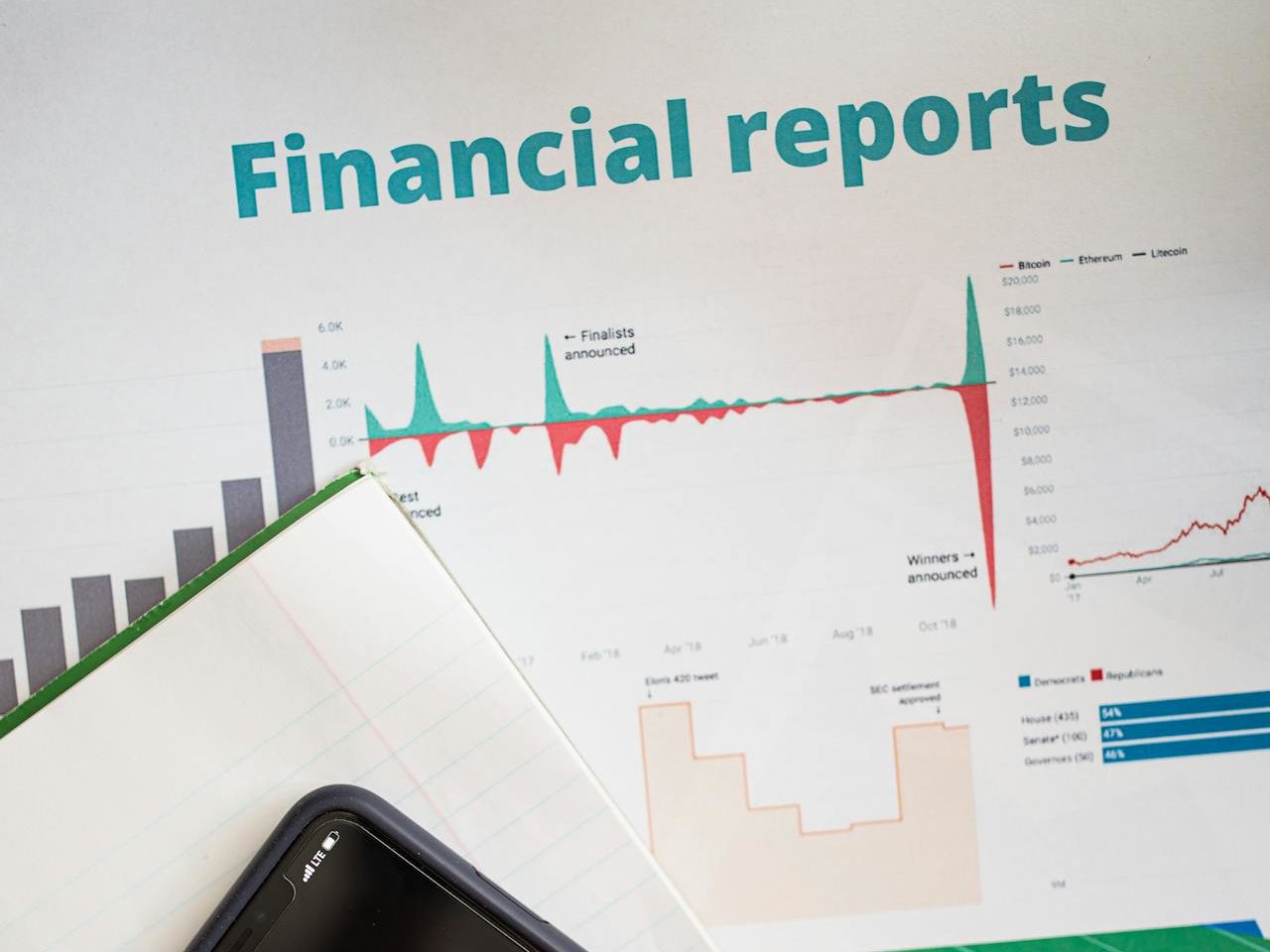As a business owner, you are swamped with a lot of tasks. You wear many hats – operator, marketer, accountant, and much more. You barely have time for yourself, let a lone a chance to review your financial reports to know and understand how things are going for your business. This shouldn’t be the case.
Reviewing financial reports should be just as important as any other task that helps your business run. They should be considered the backbone of your business and making time for them should be top priority. I know what you’re thinking! You barely have time to accomplish other tasks let alone time to review financial reports, right? Well don’t worry. In this blog, we will dive into the top 8 financial reports to review for your business every month in Canada. Before we dive in, let’s talk about what financial reports are and some helpful tips when reviewing them.
What are Financial Reports
Financial reports are essential documents that provide a snapshot of a company’s performance and position over a specific period. They serve as crucial tools not only for yourself but also for stakeholders, including investors, creditors, management, and regulatory authorities, to assess the health and sustainability of a business. Accountants or bookkeepers prepare the reports according to generally accepted accounting principles (GAAP) or international financial reporting standards (IFRS) and are typically issued on a monthly, quarterly, or annual basis.
A typical financial report contains 3 core reports – the balance sheet, income statement, and the statement of cash flow. The balance sheet shows a company’s assets, liabilities, and equity at a given point in time. Assets encompass everything a company owns and helps the business make money, such as cash, inventory, property, and equipment. Liabilities represent the company’s obligations or debts owed to other businesses or individuals and these include debts, loans, and accounts payable. Equity is the owners’ stake in the business and is calculated as the difference between assets and liabilities. By examining the balance sheet, stakeholders can gauge the company’s financial stability, liquidity, and overall worth.
Another critical financial report is the income statement, also known as the profit and loss statement. This report summarizes a company’s revenues, expenses, and net income or loss for a specific period. Revenues are generated from the sale of goods or services, while expenses include costs incurred in producing those goods or services, as well as operating expenses such as rent, utilities, and salaries. Net income is calculated by subtracting expenses from revenues and indicates the company’s profitability during the period. The income statement provides insights into the company’s revenue-generating activities, cost management strategies, and profitability trends.
The cash flow statement is another vital financial report that tracks the flow of cash in and out of a business during a specific period. It categorizes cash flows into three main activities: operating, investing, and financing. Operating activities involve cash transactions related to the company’s core business operations, such as sales receipts and payments to suppliers. Investing activities include cash flows from buying or selling assets, such as property, equipment, or investments. Financing activities encompass cash flows from obtaining or repaying debt, issuing or repurchasing stock, and paying dividends. The cash flow statement provides valuable insights into a company’s ability to generate cash, manage liquidity, and fund its operations, investments, and debt obligations.
Other reports that may be included in your financial reports are the accounts receivable aging reports and accounts payable aging reports. The additional financial tools may be added depending on how your business is operated. They track outstanding customer invoices and vendor bills, respectively. These reports help businesses monitor cash flow, identify potential collection issues or payment delays, and implement appropriate credit and payment policies.
Overall, financial reports play a vital role in facilitating transparency, accountability, and informed decision-making within organizations. By analyzing these reports, stakeholders can assess a company’s financial health, performance, and prospects, identify areas for improvement, and make strategic business decisions. Therefore, understanding and effectively utilizing financial reports are essential for achieving long-term success and sustainability in today’s dynamic and competitive business environment.
How to Review Financial Reports For Your Canadian Business

Reviewing financial reports is quite easy and anyone can do it. Business owners like yourself should be able to review these reports without the aid of an accounting professional.
There are 2 key to understanding when it comes to reviewing financial reports. One is that all the reports are connected and there is a general order in which the reports should be review in order for it to make sense. Second is that, the reports are historical and are a reflecting of the past. This means they will tell you how your business did, not how it is doing. Once you understanding this concept, reviewing them will be a breeze.
Typically, financial reports will be given to you by your accountant in the following order:
- Balance Sheet
- Income Statement
- Cashflow Statement
- Aging AR
- Aging AP
To effectively review financial reports, start with the balance sheet. Look at your assets and check to for accuracy and completeness. Assess the liabilities to see how much you owe vendors. Look at the equity to assess if any ownership values changed within the period. Look for trends, such as increasing assets or decreasing liabilities, which can indicate positive growth. Next, analyze the income statement to understand revenue, expenses, and profitability. Ask yourself if there were any irregularities or unexpected changes in revenue or expenses. Check for the connection between the income statement and the balance sheet. The net profit/loss on the income statement should show up on the balance sheet as profit for the year and should be the same number.
Now review the cash flow statement to evaluate the company’s liquidity and ability to meet its financial obligations. Pay attention to cash flow from operating activities, as it reflects the company’s core business operations. Additionally, examine accounts receivable and accounts payable aging reports to monitor cash inflows and outflows. Review if you have a negative or positive cash flow for the period you are reviewing. If your cash flow is positive, it means your business has enough money to meet future obligations. If it is negative, it means you are not liquid and you need to figure out where issues lie and how to find cash fast.
Lastly review the accounts receivable and accounts payable statements. In the accounts receivable, see how much money people owe you and follow up with them accordingly to make payments. For the accounts payable statements, see if you actually owe those on the list and make arrangements to pay them. Both the accounts payable and receivable statements are directly connected to the statement of cash flow. The faster you are able to collect money from clients/customers and pay of vendors, the more positive your cashflow will be.
Overall, as you review the statements, check for accuracy and completeness. Verify that all transactions are properly recorded and classified. Look for any discrepancies or missing information that may affect the reliability of the reports. Compare current period with previous ones in order to look for trends and patterns to identify areas of improvement or potential red flags. This analysis helps in understanding the company’s financial progress over time. Doing all these will allow for a better understanding of your business help.
Now that we know what financial reports are and how to review them, here are the top 8 financial reports to review every month for your business in Canada.
Report 1: Balance Sheet

The balance sheet offers a snapshot of your company’s financial position at a given point in time, detailing its assets, liabilities, and equity. Regular review of the balance sheet helps you gauge your business’s liquidity, solvency, and overall financial stability.
The balance sheet contains the following:
- Assets
- Liabilities
- Equity
Assets is where you will find your cash from the bank, inventory values, PPE (property, plant, and equipment), investments and accounts receivables (monies owed to the business).
The liability section of the balance sheet contains accounts payables, sales taxes owed to the government, payroll taxes, corporate taxes owed to the government, shareholder loans, bank and other loans and other obligations.
The equity section contains common stock or shares in the company, retained earnings (the profit/loss the business made since its inception), and dividends paid.
This report can be reviewed by going through each section of the report to identify inaccuracies and completeness. In additions, you can use financial ratios and formulas to make better sense of the numbers. Some of these include current ratio, debt-to-asset ratio, debt-to-equity ratio and much more.
Report 2: Profit/Loss Statement of Income Statement

The profit/loss statement is one of the most important and most popular reports used by businesses. It shows the sales or revenue the business made in a given period as well as the expenses for that report. The difference between the revenue and expenses gives the profit/loss for the business in that given period.
The report is broken down into 2 main sections:
- Revenue or Sales
- Expenses
Revenue is the gross number of sales made by the business for a given period. Expenses are the things the business spent money on in order to operate such as rent, software, utilities, insurance, advertising, raw material, etc.
This report tells businesses if they are profitable or not. A positive difference means the business made a profit whereas a negative number means the business made a loss. This report can be used to identify trends in the business and make changes as necessary. It can also be used with a budget to show if the business is meeting projections.
Report 3: Statement of Cash Flow

The Cash Flow Statement is one of the most overlooked financial statements but also one of the most important financial reports that provides insights into how cash moves in and out of your business during a specific period. It categorizes cash flows into three main sections: operating activities, investing activities, and financing activities.
- Operating Activities: Operating activities represent the cash inflows and outflows resulting from the core business operations of the company. This section includes transactions such as sales revenue, payments to suppliers, salaries, and other operating expenses.
- Investing Activities: Investing activities involve cash flows related to the purchase and sale of long-term assets, such as property, equipment, and investments. This section also includes expenditures on research and development or acquisitions.
- Financing Activities: Financing activities encompass cash flows associated with raising capital and repaying debt. This section includes transactions such as issuing or repurchasing shares, obtaining loans, and paying dividends or interest. Understanding cash flows from financing activities helps in evaluating the company’s capital structure, debt obligations, and dividend policies.
By reviewing the cashflow statement regularly, you can ensure liquidity. By monitoring cash flows regularly, you can identify potential cash shortages in advance and take proactive measures to address them, such as negotiating extended payment terms with vendors or securing a line of credit.
You can also manage working capital better. Working capital is the difference between current assets (such as cash, accounts receivable, and inventory) and current liabilities (such as accounts payable and short-term debt). Positive working capital indicates that the business has enough short-term assets to cover its short-term liabilities. Monitoring cash flows helps in managing working capital effectively by optimizing the timing of cash inflows and outflows, reducing inventory levels, and improving accounts receivable collection.
Cash flow analysis is also crucial for supporting business growth and expansion initiatives. Positive cash flows provide the financial resources needed to invest in new opportunities, such as launching new products or entering new markets. By understanding the cash flow implications of growth strategies, businesses can make informed decisions and avoid overextending their financial resources.
Lastly, you can mitigate financial risk. This means maintaining adequate cash reserves to buffer against revenue fluctuations or unforeseen expenses, ensuring the business remains resilient during challenging times. Additionally, a healthy cash flow position enhances the company’s credibility with lenders, investors, and other stakeholders.
Report 4: Aging Accounts Receivable Report

The Aging Accounts Receivable Report (AR report) gives businesses insight on outstanding customer invoices and the duration in which they have been outstanding for. It categorizes receivables based on the length of time they have been outstanding, typically into aging buckets such as current, 30 days past due, 60 days past due, 90 days past due, and over 90 days past due.
Regular review of this report help you identify overdue accounts quickly and follow-up with clients to collect payment. It also helps you identify trends in customers who tend to pay late. This is vital to create or enforce policies to minimize the occurrence of overdue accounts in the future.
This report is directly connected to the cashflow statement. Having lots of overdue invoices will result in a decrease in your cashflow or mean you have to run the business. By using this report to collect payments quickly, you can an accelerate cash inflows, improve liquidity, and ensure timely payment of their own obligations, such as vendor payments and operating expenses.
Analyzing the AR report also helps in developing targeted collection strategies. For example, accounts that are just past due may require a friendly reminder or follow-up call, while accounts that are significantly overdue may necessitate more assertive collection actions, such as sending collection letters or initiating legal proceedings. Tailoring collection efforts based on the age and amount of receivables enhances the effectiveness of the collections process.
Report 5: Aging Accounts Payable Report

The Aging Accounts Payable report (AP report) is very similar to the aging AR report. They are also categorized based on the length of time they have been outstanding, typically into aging buckets such as current, 30 days past due, 60 days past due, 90 days past due, and over 90 days past due. The difference between aging AP reports and AR report is that while an aging AR report shows the customers that owe your business money. The aging AP report shows the vendors that your business owes money to.
Reviewing the AP report allows you to build healthy relationships with your business. By identifying invoices that are approaching or past their due dates, businesses can ensure timely payment to vendors, avoiding late payment penalties and maintaining credibility with suppliers. Timely payment management also fosters trust and reliability in business relationships, which can lead to favourable terms and discounts from vendors. You can also communicate proactively with vendors regarding payment status and address any concerns or discrepancies promptly. Building strong supplier relationships fosters collaboration, flexibility, and mutual trust, which can lead to long-term benefits for both parties.
The report also allows you to plan ahead by forecasting cashflow requirements and making payments plans accordingly.
Report 6: Budget vs Actual Report

A budget vs actual report is a report that shows how much was budgeted for a business and how much was actually used. These reports are great to analyze projected amounts and determine if the business is within or outside those amounts. The report is usually tied in with the trial balance as this report shows all the monies used for the business.
The Budget vs. Actual Report serves as a roadmap for taking corrective actions to address unfavourable variances and capitalize on favourable ones. For example, if expenses exceed budgeted amounts in a particular department, management may implement cost-cutting measures, renegotiate contracts, or reallocate resources to align with budget targets. Similarly, if revenues fall short of expectations, marketing initiatives or sales strategies may be adjusted to boost sales performance.
Regular review of the Budget vs. Actual Report provides valuable feedback for improving the accuracy of future budgeting and forecasting processes. By analyzing past variances and understanding the factors contributing to them, businesses can refine their budgeting assumptions, incorporate lessons learned, and develop more realistic forecasts for the future.
Report 7: Inventory Valuation Report

If you sell products, this report is one of the most important to review on a monthly basis. The inventory valuation report provides an overview of the value of your inventory at a specific point in time. It helps you monitor inventory levels, assess inventory turnover, and identify potential obsolescence or shrinkage.
Using this report, you can identify stock levels for each inventory items and see if you are overstocked or understocked. This will allow you to maintain an ideal level of inventory items in stock to prevent carrying costs, or excess inventory write-offs.
The report also allows you to calculate for inventory turnover ratio, which measures how quickly inventory is sold and replaced within a given period. A high inventory turnover ratio indicates efficient inventory management, while a low ratio may suggest excess inventory or slow-moving items.
Report 8: Key Performance Indicators (KPIs) Report/Dashboard

The Key Performance Indicators (KPI) are metrics that a business uses to measure success or failure. The help easily track if the business is meeting goals or deadlines. KPIs may include metrics such as gross profit margin, net profit margin, return on investment (ROI), current ratio, and debtor days. You can choose to include any metrics that are important to monitor for your business. Regularly monitoring KPIs enables you to track progress towards goals and make data-driven decisions.
KPIs are directly tied to all the other financial statements and are one of the few reports that can be viewed daily instead of monthly. Since they pull and summarize data from other reports such as balance sheets, income statements, statements of cashflow and more, they allow you to quickly see the health of the business in one report, without having to view all the other reports.
Conclusion to Top 8 Financial Reports for Canadian Businesses
So, there you have it. Eight financial reports to review every month for your business. These reports are the most important most businesses review however, they are not set in stone. You can add or remove reports based on the needs of your business. One thing is certain – regularly reviewing these top 8 accounting reports provides invaluable insights into your business’s financial performance, enabling you to make informed decisions and steer your company towards success. By leveraging the data provided by these reports, you can proactively address challenges, capitalize on opportunities, and drive sustainable growth.
Remember, while reviewing these reports monthly is essential, it’s equally important to understand the context behind the numbers and take appropriate action based on your findings. With diligent financial management and informed decision-making, you can navigate challenges effectively and position your business for long-term success.


